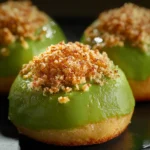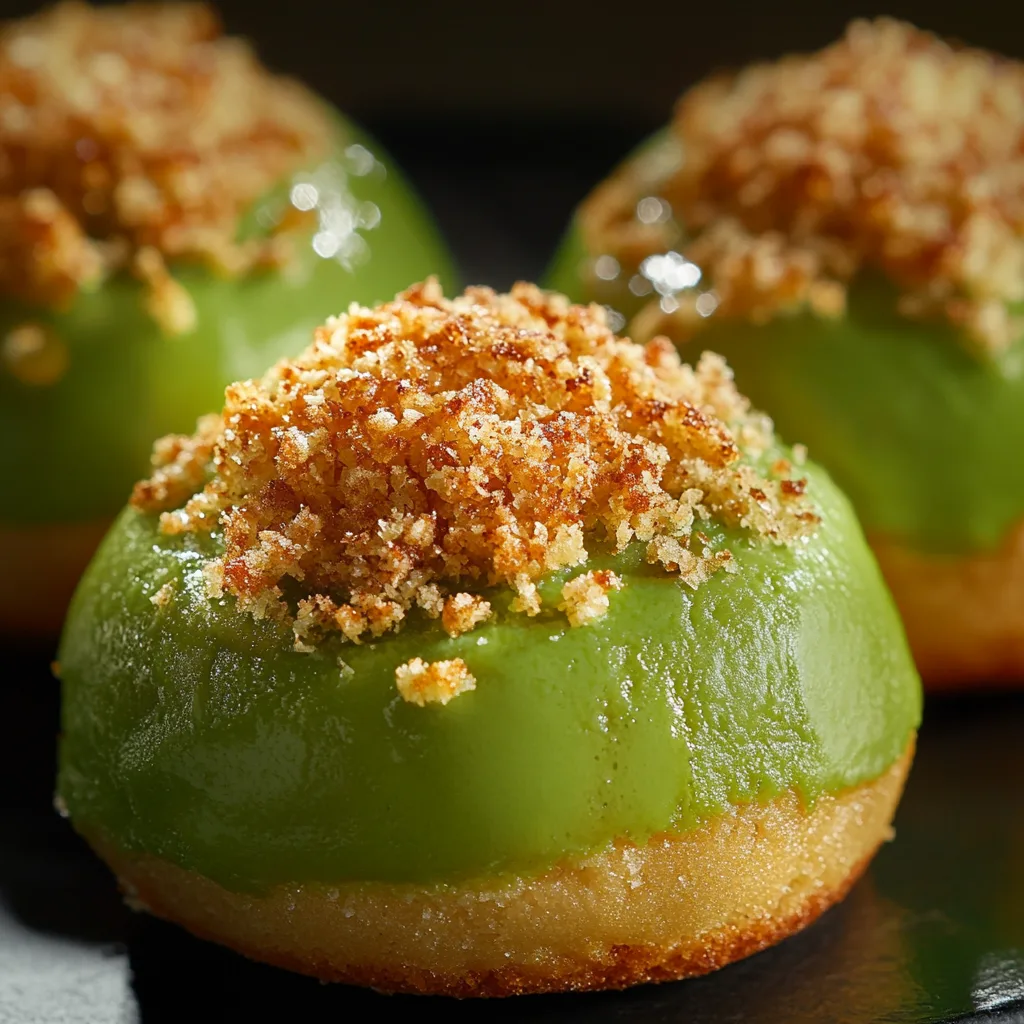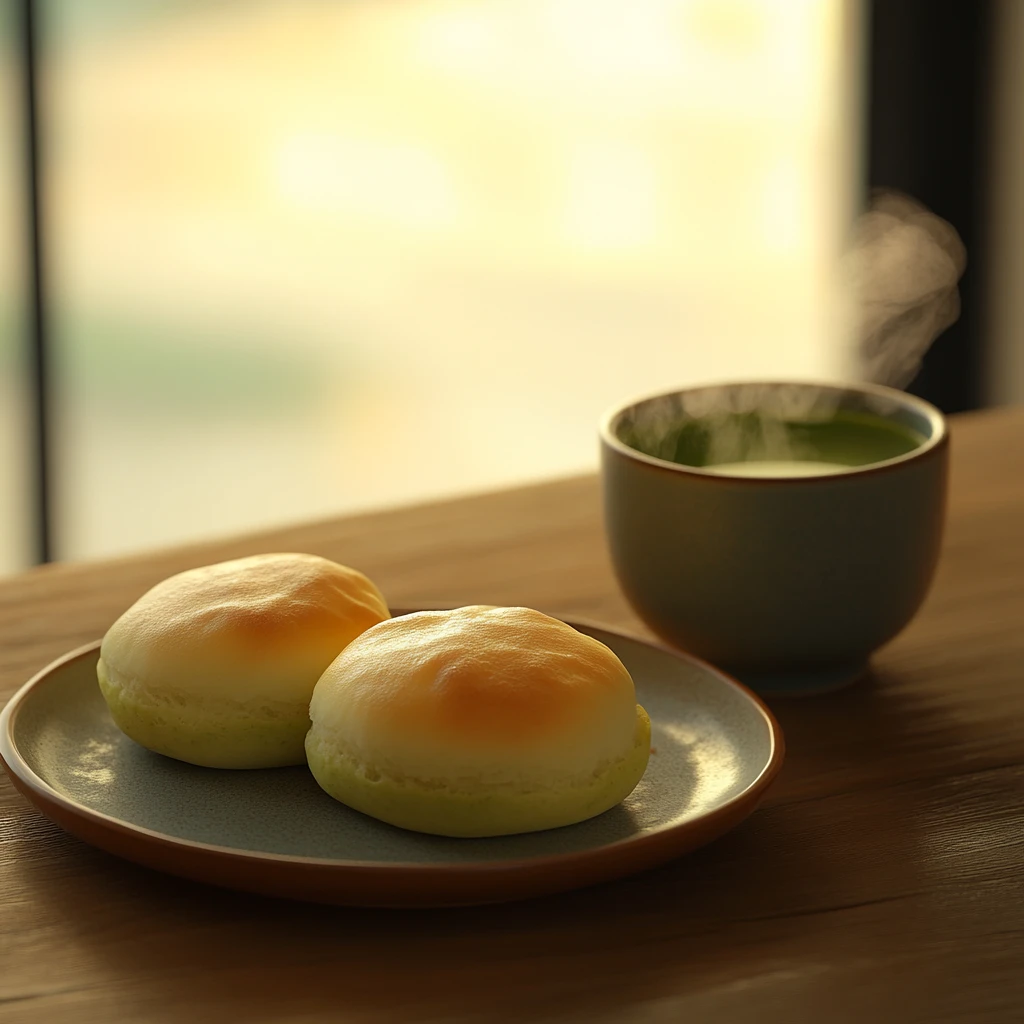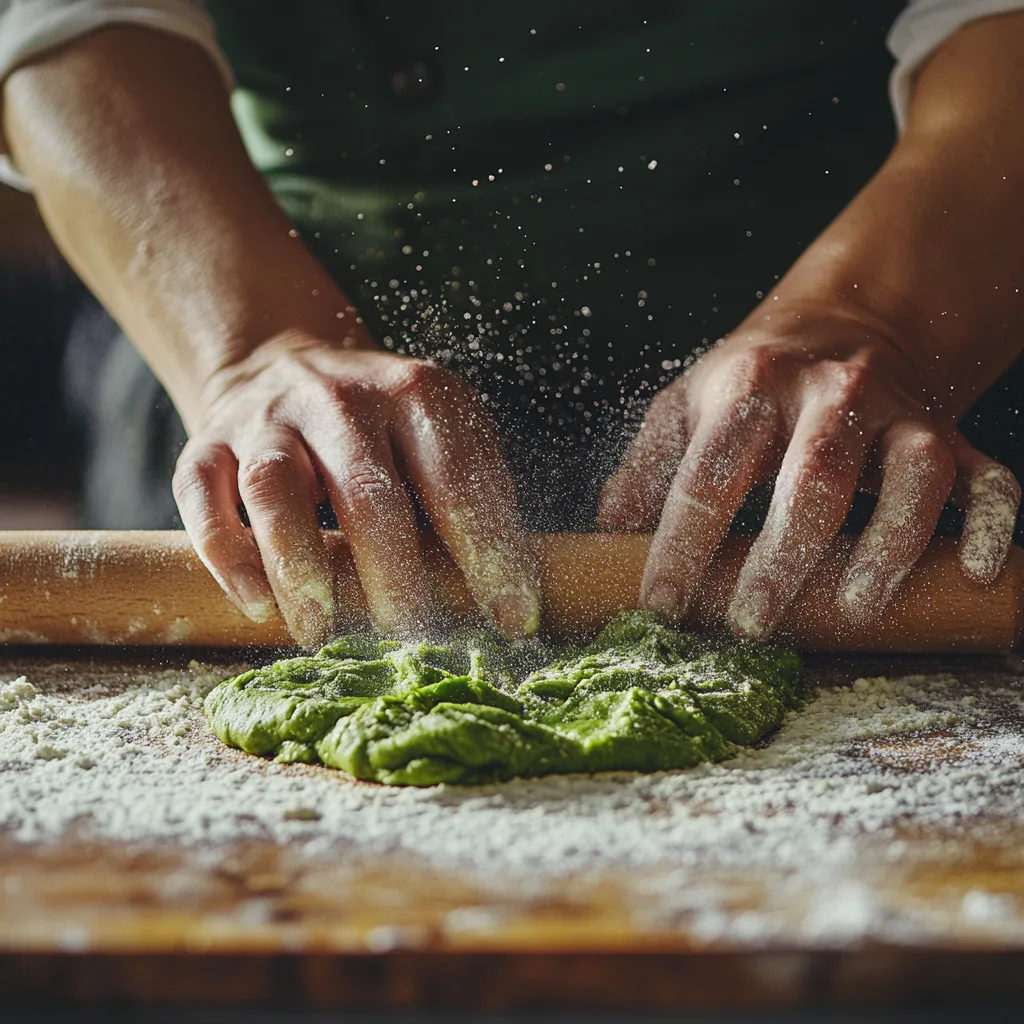Discover the Delight of Matcha Pan, Japan’s Iconic Sweet Bread
In the world of Japanese sweet breads, matcha pan stands out as a true delicacy. This delightful creation features a soft, pillowy interior encased in a crisp, cookie-like topping. As a result, the textural contrast has won the hearts of pastry enthusiasts worldwide. Drawing inspiration from traditional melon pan, matcha pan incorporates the distinctive earthy flavor of green tea powder. Consequently, it adds both visual appeal and a complex taste profile that balances sweetness with umami notes.
As matcha-infused desserts gain momentum across global culinary scenes, matcha pan has therefore emerged as a standout offering. The vivid green hue and unique flavor combination make it not just a treat for the taste buds. In addition, it’s also a feast for the eyes.

What Is Matcha Pan?
At its core, matcha pan is a Japanese sweet bread with two distinct components. Specifically, it combines a soft, fluffy bread base with a crunchy, cookie-like topping infused with matcha powder. The interior provides a gentle, yielding texture. Meanwhile, the outer layer delivers a satisfying crispness with each bite.
What makes matcha pan special is undoubtedly the interplay between flavors. The earthy, slightly bitter notes of the green tea powder contrast with the bread’s sweetness. As a result, this balance creates a multi-dimensional flavor experience that’s both sophisticated and comforting.
Print
How to Make Matcha Pan – The Perfect Japanese Sweet Bread
- Total Time: 2 hours 15 minutes
- Yield: 8 buns 1x
- Diet: Vegetarian
Description
Matcha Pan is a delicious Japanese sweet bread featuring a soft, fluffy interior and a crisp, matcha-infused cookie crust. Inspired by traditional melon pan, this bread combines the earthy bitterness of matcha with a lightly sweet, buttery flavor, making it a must-try for pastry lovers.
Ingredients
For the Dough:
- 3 cups bread flour
- 1 tablespoon matcha powder
- 3/4 cup warm milk (about 110°F / 43°C)
- 2 1/4 teaspoons active dry yeast
- 1/4 cup sugar
- 1/2 teaspoon salt
- 2 tablespoons dry milk powder
- 2 beaten eggs
- 1/4 cup softened butter
For the Cookie Crust:
- 1/2 cup softened unsalted butter
- 1/3 cup powdered sugar
- 1 cup all-purpose flour
- 1 tablespoon matcha powder
- A pinch of salt
- 1 egg white
- 1/2 teaspoon vanilla extract
Instructions
Preparing the Dough:
- Warm the milk until just tepid (110°F / 43°C).
- Combine warm milk, yeast, and 1 tablespoon of sugar in a bowl. Let sit for 5-10 minutes until foamy.
- In a separate bowl, whisk bread flour, matcha powder, sugar, salt, and dry milk powder.
- Add the yeast mixture and beaten eggs to the dry ingredients. Mix until just combined.
- Knead the dough, gradually adding softened butter, for about 8-10 minutes until smooth and elastic.
- Place the dough in a greased bowl, cover, and let it rise for about 1-1.5 hours until doubled in size.
Making the Cookie Topping:
- Cream together the butter and powdered sugar until light and fluffy.
- In a separate bowl, whisk together the flour, matcha powder, and salt.
- Gradually add the dry ingredients to the butter mixture.
- Add the egg white and vanilla extract, mixing until a soft dough forms.
- Wrap the dough in plastic wrap and refrigerate for at least 30 minutes.
Shaping and Assembling:
- Once the dough has doubled in size, gently punch it down.
- Divide into 8 equal portions and roll each into a ball.
- Roll out the cookie topping into 8 thin circles between parchment paper.
- Drape a circle of cookie dough over each ball of bread dough, then score the tops with a crisscross pattern.
- Cover loosely and let rise for another 30-40 minutes.
Baking Instructions:
- Preheat oven to 375°F (190°C).
- Bake for 12-15 minutes until the cookie topping is lightly golden.
- Let cool for 5 minutes on the baking sheet, then transfer to a wire rack.
- Enjoy while still slightly warm for the best texture contrast!
Notes
- For a more intense matcha flavor, increase the matcha powder in the cookie crust.
- Store leftovers in an airtight container at room temperature for up to 2 days.
- You can reheat matcha pan slightly before serving to restore its crisp texture.
- Dairy-free options: Use plant-based milk and vegan butter.
- Gluten-free variation: Use a blend of gluten-free flours for both dough and cookie crust.
- Prep Time: 2 hours (including rise time)
- Cook Time: 15 minutes
- Category: Bread, Dessert
- Method: Baking
- Cuisine: Japanese
Nutrition
- Serving Size: 1 bun
- Calories: 280 kcal
- Sugar: 12g
- Sodium: 10g
- Fat: 6g
- Carbohydrates: 40g
- Fiber: 2g
- Protein: 6g
- Cholesterol: 45mg
Keywords: Matcha pan, Japanese sweet bread, matcha melon pan, green tea bread, matcha bun, matcha pastry, melon pan, Japanese bakery
Popular Variations of Matcha Pan

The most popular version—matcha melon pan—features a signature cracked crust pattern. Notably, this distinctive appearance resembles a melon’s exterior (hence the name). Furthermore, the vibrant green color makes matcha pan instantly recognizable. Consequently, it’s increasingly sought-after by food enthusiasts and casual snackers alike.
The Origins and Cultural Significance of Matcha Pan in Japanese Baking
Melon pan has been a staple in Japanese bakeries for decades. In fact, it represents the beautiful fusion that occurred when European bread-making techniques met Japanese culinary traditions. Additionally, the addition of a sweet, crispy cookie topping transformed a simple sweet bread into something uniquely Japanese.
The Evolution of Matcha in Japanese Baking
Bakers began experimenting with different flavors beyond vanilla or chocolate. Subsequently, matcha emerged as a natural choice given its deep roots in Japanese culture. Historically, matcha has been integral to Japanese tea ceremonies for centuries. Indeed, it’s prepared with meticulous attention and consumed with mindful appreciation.
The transition of matcha from ceremonial beverage to popular baking ingredient shows the evolution of Japanese culinary traditions. Moreover, its distinctive umami taste and health benefits made it a favorite in modern desserts. This therefore allows bakers to create treats that honor tradition while appealing to contemporary tastes.
The Health Benefits of Matcha in Japanese Sweet Bread

Matcha’s surge in popularity extends beyond its cultural significance. Above all, its flavor profile offers a sophisticated alternative to common flavors. It’s mildly sweet, slightly grassy, and distinctly umami-rich. Unlike artificial additives, matcha provides natural color and flavor. As a result, this appeals to today’s health-conscious consumers.
Versatility in Cooking
The versatility of matcha as an ingredient has furthermore contributed to its widespread use. It pairs well with both sweet elements and savory components. Thus, it makes an excellent choice for creative culinary applications. In matcha pan, the earthiness creates a beautiful counterpoint to the bread’s sweetness.
Social Media Influence
Social media platforms have subsequently catapulted matcha-based desserts to international fame. First of all, the vibrant green color makes for eye-catching photographs. Secondly, the perceived health benefits have increased its presence in trendy bakeries worldwide. This visibility therefore creates a positive feedback loop. Consequently, more consumers seek out matcha-infused treats, and more establishments offer them.
Key Ingredients for Making Matcha Pan
Dough Ingredients
Creating perfect matcha pan starts with a carefully crafted dough. Essentially, it needs the ideal balance of softness and structure:
- Bread Flour: Primarily provides necessary gluten structure while maintaining softness.
- Matcha Powder: Specifically imparts subtle green color and distinctive earthy flavor.
- Milk: Not only adds richness but also creates a tender crumb structure.
- Butter: Similarly contributes softness and adds subtle richness.
- Active Dry Yeast: Obviously the leavening agent responsible for the bread’s rise.
- Sugar: On one hand balances matcha’s bitterness while on the other hand feeds the yeast.
- Eggs: Furthermore add richness, color, and help bind ingredients together.
- Salt: Finally enhances flavors and controls yeast activity.
Cookie Crust Ingredients
The signature crunchy topping likewise requires its own special blend:
- Unsalted Butter: In particular creates a crisp, melt-in-your-mouth texture.
- Powdered Sugar: Similarly dissolves seamlessly for light sweetness without graininess.
- All-Purpose Flour: Naturally provides structure to the cookie layer.
- Matcha Powder: Again adds color and flavor to the topping.
- Egg Whites: Additionally bind ingredients while encouraging crispness.
- Vanilla Extract: Lastly enhances sweetness and adds depth.
Dietary Alternatives
For those with dietary restrictions, matcha pan can definitely be adapted:
- Dairy-Free Options: Alternatively, plant-based milks and vegan butter work well.
- Gluten-Free Variations: Similarly, a blend of gluten-free flours can replace wheat flour.
- Low-Sugar Alternatives: Additionally, natural sweeteners can reduce sugar content.
Step-by-Step Guide to Making Matcha Melon Pan

Preparing the Dough
- First, warm 3/4 cup of milk until just tepid (about 110°F or 43°C).
- Next, pour warm milk into a mixing bowl with 2 1/4 teaspoons of active dry yeast and 1 tablespoon of sugar.
- Then, stir gently and let sit for 5-10 minutes until foamy.
- Meanwhile, in a separate bowl, whisk together 3 cups of bread flour, 1 tablespoon of matcha powder, 1/4 cup of sugar, 1/2 teaspoon of salt, and 2 tablespoons of dry milk powder.
- After that, add the yeast mixture and 2 beaten eggs to the dry ingredients.
- Subsequently, mix until just combined.
- Then, begin kneading the dough, gradually adding 1/4 cup of softened butter.
- Continue kneading for 8-10 minutes until smooth and elastic.
- Finally, place in a greased bowl, cover, and let rise for about 1-1.5 hours.
Making the Cookie Topping
- While the dough rises, prepare the cookie topping.
- First of all, cream together 1/2 cup of softened butter and 1/3 cup of powdered sugar.
- In a separate bowl, whisk 1 cup of flour, 1 tablespoon of matcha powder, and a pinch of salt.
- Then, gradually add the flour mixture to the butter mixture.
- Next, add 1 egg white and 1/2 teaspoon of vanilla extract.
- After that, mix until a soft dough forms.
- Finally, wrap in plastic and refrigerate for at least 30 minutes.
Shaping and Assembling
- After the bread dough has doubled, first punch it down gently.
- Next, divide into 8 equal portions and shape each into a ball.
- Then, place them on a parchment-lined baking sheet, leaving space between each.
- Meanwhile, remove the chilled cookie dough and divide it into 8 portions.
- Subsequently, roll each portion into a thin circle between parchment paper.
- Afterward, drape a circle of cookie dough over each ball of bread dough.
- Then, score the top of each bun in a grid pattern.
- Finally, cover loosely and let rise for another 30-40 minutes.
Baking Instructions
- First, preheat your oven to 375°F (190°C).
- Then, bake for 12-15 minutes until the cookie topping is lightly golden.
- Afterward, cool on the baking sheet for 5 minutes before transferring to a rack.
- Lastly, enjoy while still slightly warm for the best texture contrast.
The Health Benefits of Matcha in Baking
While matcha pan is a treat, it nonetheless offers nutritional advantages rarely found in other sweet breads. The matcha powder brings health benefits that have consequently contributed to its growing popularity.
Antioxidant Powerhouse
Matcha is remarkably rich in antioxidants, particularly catechins like EGCG. These compounds help combat oxidative stress and inflammation. Unlike steeped green tea, matcha involves consuming the entire leaf. As a result, this maximizes its nutritional potential.
Natural Energy Boost
The natural caffeine in matcha works in harmony with L-theanine to provide sustained energy. Unlike coffee, there’s no crash afterward. Therefore, this makes matcha pan an excellent mid-afternoon snack. It satisfies sweet cravings while simultaneously providing gentle alertness.
Metabolic Support
Research suggests that matcha compounds may support metabolism. Specifically, they can increase thermogenesis (the rate at which the body burns calories). While matcha pan contains sugar like any sweet bread, the matcha nevertheless adds a beneficial dimension.
Mental Clarity and Relaxation
One of matcha’s most prized qualities is undoubtedly promoting relaxation and mental clarity. L-theanine induces alpha wave activity in the brain. Consequently, this creates relaxed alertness that tea masters recognized centuries ago. Enjoying matcha pan can therefore be a mindful moment of tranquility.
Heart Health Benefits
The cardiovascular benefits of matcha shouldn’t be overlooked either. Regular consumption has been linked to improved heart health. In particular, it may reduce cholesterol levels and improve blood pressure. Matcha pan can thus contribute to overall wellness as part of a balanced diet.
More Matcha Delights and Bread Recipes to Try
Matcha Pan is just one of the many ways to enjoy the earthy, slightly bitter, and subtly sweet flavors of matcha in baked goods. If you’re a fan of matcha-infused treats, why not explore other delicious recipes? For a quick and fluffy option, try these Matcha Muffins, which perfectly balance matcha’s richness with a soft, moist texture. If you’re craving more baked goods, check out these Irresistible Cookie Recipes for unique and flavorful treats.
For those who love bread baking, you might enjoy making this Crusty Italian Bread, a rustic and hearty alternative to sweet bread. And if you’re looking for healthier homemade options, why not try making The Healthiest Burger or a Simple 4-Ingredient Banana Bread for a quick and wholesome treat?
FAQs About Matcha Pan and Matcha in General
Is it OK to drink matcha every day?
For most healthy adults, consuming matcha daily is generally safe and potentially beneficial. Its antioxidant content and moderate caffeine make it suitable for regular consumption. However, those sensitive to caffeine should consult healthcare providers. Additionally, consider the total sugar intake when enjoying matcha pan regularly.
What does drinking matcha do to your body?
Matcha affects the body in several ways. First of all, short-term effects include enhanced alertness due to caffeine and L-theanine. Many report sustained energy without jitteriness. Furthermore, long-term benefits may include improved metabolism and reduced oxidative stress. Research suggests it may also support cell repair and help manage inflammation.
What are the matcha tools called?
Traditional matcha preparation involves specialized tools with Japanese names. First, the bamboo whisk (chasen) creates perfect frothy consistency. Second, the measuring scoop (chashaku) portions the powder. Third, the tea bowl (chawan) provides ideal shape for whisking. Fourth, a fine sieve (furui) prevents clumps. Finally, many use a ceramic container (chaki) for storage.
Does matcha burn belly fat?
Some research suggests matcha may support weight management through increased thermogenesis. Specifically, matcha contains catechins that may enhance metabolism during exercise. However, these effects are relatively modest. They work best alongside a balanced diet and regular activity. In reality, no food can target specific areas for fat loss. Therefore, consider matcha pan’s overall calories as part of your nutritional intake.
Food Safety Reminder
When preparing homemade matcha pan or any baked goods, always follow proper food handling procedures. Store your finished matcha pan in an airtight container at room temperature for 2-3 days, or refrigerate for up to a week. For more comprehensive information on food safety practices and guidelines, visit the FDA Food Safety website.
